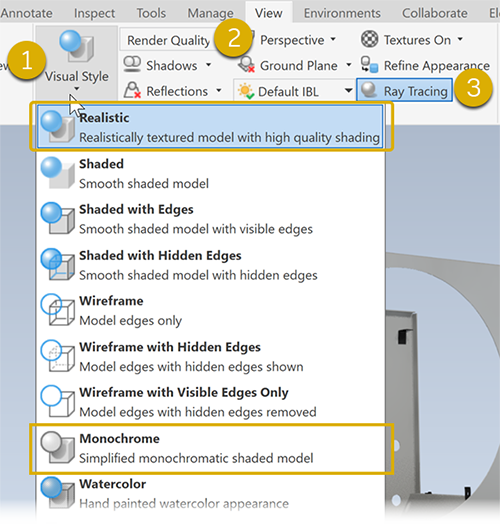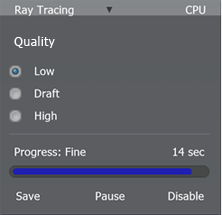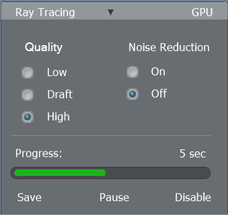View designs automatically or manually, specify mode, display and save as an image, or disable ray tracing.
Changing the view orientation, or starting another command interrupts the ray tracing process. Where applicable, such as when using Orbit, the ray trace process reinitializes when the active command ceases to be used. For other commands, ray tracing disables automatically. To re-enable ray tracing use the ribbon access point.
When you enable ray tracing, the dialog displays in the lower right corner of the canvas. The process begins using the default settings. After a few seconds into the rendering process the ray tracing dialog auto-hides. Moving the cursor into the dialog area causes the dialog to expand.
- By default, Ray Tracing is not enabled to automatically render the scene.
- Ray tracing is enabled only for Realistic and Monochrome visual styles.
- If your computer has a compatible GPU you can choose either CPU or GPU for rendering with ray tracing.
CPU or GPU Mode
CPU mode is the default and requires no selection to use. GPU mode has specific hardware requirements and must be selected to use it. See About Ray Tracing for more about the hardware requirements.
If using CPU mode, proceed to CPU Ray Tracing below.
To use GPU mode do the following:
- Go to
Tools
 Options and click
Application Options.
Options and click
Application Options.
- Click the Hardware tab.
- At the bottom of the dialog, select
Enable Viewport GPU Ray Tracing. If the hardware is compatible, the option is available.
 Note: See GPU Ray Tracing below for information about the dialog.
Note: See GPU Ray Tracing below for information about the dialog.
CPU Ray Tracing
- On the
View tab
 Appearance panel
Appearance panel Visual Style select either
Realistic or
Monochrome.
Visual Style select either
Realistic or
Monochrome.
- In Graphics Presets choose Render Quality.
- Click
Ray Tracing.

The Ray Tracing dialog displays in the lower right corner of the canvas.
- Select an option in
Quality.

- Low
- Rough and semi-rough materials are approximated. Consequently, materials may look shinier than expected. Direct lighting is approximated and indirect lighting is treated as a constant ambient color. Shadows will lack in details. Useful for quick previews of outdoor/product renderings, but unsuitable for interior scenes.
- Draft
- Rough and semi-rough materials are approximated. Consequently, materials may look shinier than expected. Lighting is approximated so shadows will lack in details. Useful for quick previews.
Tip: Draft often provides a satisfactory result without the lengthy time it takes for High.
- High
-
Soft shadows and soft reflections from semi-rough materials will be rendered with a high quality level. This is the standard setting for final high quality renderings.
GPU Ray Tracing

- Quality (Low/Draft/High). This controls the target quality level of the rendered result. Higher quality takes longer to complete but will have fewer artifacts.
- Noise Reduction. This applies a "denoising" filter to the result, which allows for the immediate reduction of noise artifacts, which is much faster to render. Denoising can result in some loss of detail in materials or lighting, but often provides a good and rapid result.
Progress
The lower section of the Ray Tracing dialog provides feedback about the time used for the rendering and commands for saving, pausing, and disabling the ray trace render. Clicking any of these commands to interrupt the rendering process at any time. To resume rendering, click Continue.
- Save
- Saves the image at its current resolution state. Specify the name file type, and location in the Save As dialog.
- Pause/Continue
- Interrupts the ray tracing process. Click continue to resume. Scene changes such as orbit, zoom, and so on will cause the render to start over.
- Disable
- Halts the ray tracing process and returns to raster display mode. See below for more options.
Save Ray Tracing Result as an Image
- On the File menu, click Save As
 Save Copy As.
Save Copy As.
- Specify a name, file type, and location for the image.
- Click OK and click Save.
Disable Ray Tracing
- In the Ray Tracing dialog, click Disable.
- On the ribbon View tab, Appearance panel, click Ray Tracing.
- Change from the Realistic or Monochrome visual style to any other visual style.
- Activate a command that disables ray tracing.
- Modify the application option or document display settings to remove the automatic setting from the Realistic visual style.
Use one of the following methods:
Automatically View Designs with Ray Tracing
By default Ray Tracing is disabled. You can enable it for all models as an application option or on a per document basis using Document Appearance settings. Because ray tracing works only with two specific visual styles it automatically initializes only when one of those styles is active.
- In the
Tools tab
 Options panel click
Application Options.
Options panel click
Application Options.
- On the
Display tab
 Appearance section
specify application settings.
Appearance section
specify application settings.
- Click Settings, and in the dialog Realistic Visual Style section check Enable Ray Tracing. Ray tracing is automatically enabled when you open the file.
To use application settings:
- In the
Tools tab
 Options panel click
Application Options.
Options panel click
Application Options.
- On the
Display tab
 Appearance section
specify document settings.
Appearance section
specify document settings.
- Click Settings, and in the dialog Realistic Visual Style section check Enable Ray Tracing. Ray tracing is automatically enabled when you open the file.
To use document settings: